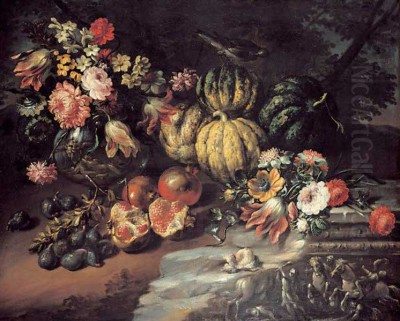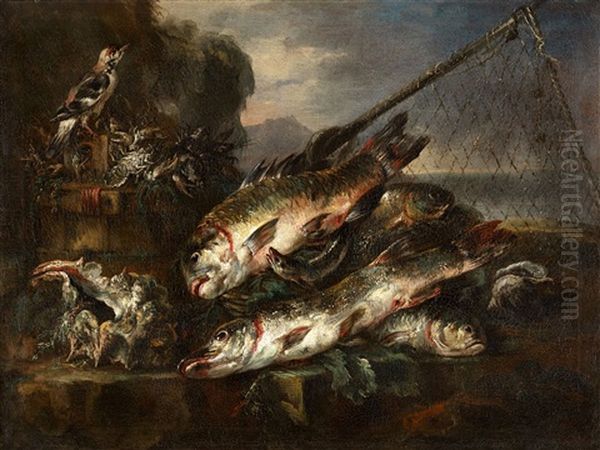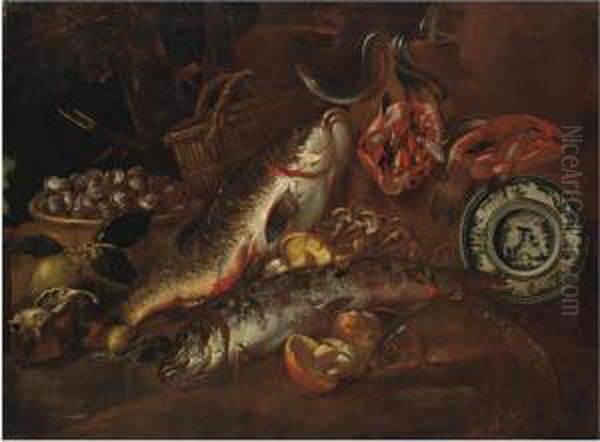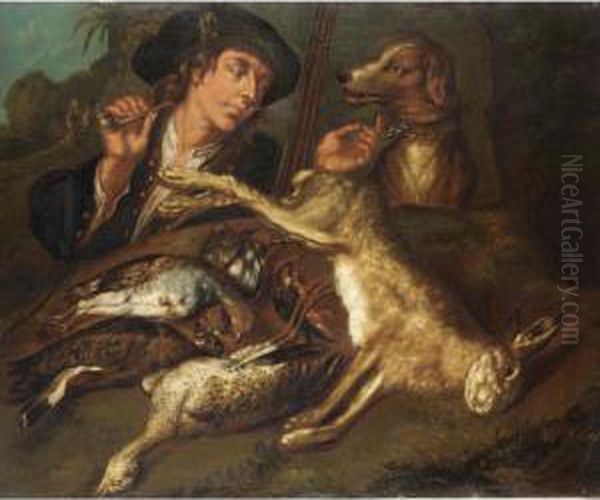
Felice Boselli stands as a significant, if sometimes overlooked, figure in the rich tapestry of Italian Baroque art. Active primarily during the latter half of the 17th and the early 18th centuries, Boselli carved a distinct niche for himself as a painter of still lifes, particularly those teeming with animals, game, fish, and the vibrant, often visceral, elements of kitchen and market scenes. His work, centered largely around the cities of Piacenza and Parma in the Emilia-Romagna region, offers a compelling blend of Northern European influences and a robust Italian naturalism.
Born in Piacenza in 1650, Boselli lived a long life, passing away in Parma in 1732. This lifespan placed him squarely within the High and Late Baroque periods, a time of dramatic artistic expression across Europe. While Italy was renowned for its grand religious and historical paintings, spearheaded by artists like Caravaggio (whose naturalistic revolution echoed down the century) and later masters such as Luca Giordano and Carlo Maratta, there was also a burgeoning market and appreciation for still life painting. Boselli emerged as one of the genre's most dedicated and prolific practitioners in his region.
Early Life and Influences
Details about Boselli's formal training remain somewhat scarce, a common issue for artists outside the major metropolitan centers like Rome or Florence. However, some sources suggest a possible, though not definitively confirmed, tutelage under Michelangelo Pace, known as "Campidoglio," a Roman still life painter. More speculatively, connections have been drawn to figures associated with French classicism, such as the sculptor François Girardon, though this link seems less direct regarding painting style. What is undeniable is the profound impact of Northern European, particularly Flemish, still life traditions on his work.

The influence of Flemish masters like Frans Snyders and Jan Fyt, renowned for their dynamic and often large-scale depictions of game, hunting scenes, and overflowing market stalls, is evident in Boselli's compositions and subject matter. The meticulous attention to texture – the softness of feathers, the glint of fish scales, the rough hide of game – echoes the Northern European obsession with realistic rendering. Artists like Adriaen van Utrecht also specialized in similar themes. However, Boselli did not merely imitate; he assimilated these influences into a distinctly Italian, specifically Emilian, sensibility. His work often possesses a certain earthiness and dramatic flair that feels rooted in the local culture and landscape.
Artistic Style and Themes
Boselli's artistic identity is firmly anchored in naturalism and realism. He approached his subjects with a keen observational eye, striving to capture their physical presence with accuracy. His canvases are frequently filled with an abundance of life, albeit often stilled by the hunter or the fisherman. Dead game birds, hares, poultry, heaps of glistening fish, crustaceans, and occasionally larger animals like slaughtered pigs or calves are recurring motifs. These are often arranged in kitchen settings, on pantry shelves, or seemingly fresh from the market, sometimes accompanied by vegetables, copper pots, or simple earthenware.
A characteristic feature of many Boselli paintings is his use of chiaroscuro – strong contrasts between light and shadow. Subjects are often dramatically illuminated against dark, somewhat undefined backgrounds, lending them a heightened sense of presence and theatricality. This technique, ultimately derived from Caravaggio's innovations, was widely adopted during the Baroque period to enhance emotional impact and visual drama. Boselli employed it effectively to focus the viewer's attention on the textures, forms, and sheer physicality of the objects depicted.
His color palette could be rich and vibrant, particularly in rendering the plumage of birds or the varied hues of fish, yet often set within an overall darker, sometimes described as "smoky," tonality. His brushwork, while detailed, could also be vigorous and expressive, contributing to the lively, almost tangible quality of his subjects. Beyond mere depiction, some scholars suggest Boselli's work occasionally carries undertones of social commentary or satire, observing the bounty and the labor associated with rural and lower-class life, a focus less common among the more aristocratic leanings of mainstream Baroque art.
Masterpieces and Signature Works
While Boselli was prolific, with estimates suggesting around one hundred known works, certain paintings stand out as representative of his style and thematic concerns.

Still Life with Slaughtered Pig (Nature morta con maiale ucciso a freddo): This type of subject, while perhaps unsettling to modern eyes, was not uncommon in Baroque still life, reflecting the realities of food preparation and rural economy. Boselli's treatment would likely emphasize the anatomical reality of the animal, the texture of its skin, and the tools of the butcher, presenting it with an unflinching naturalism that is characteristic of his approach. It highlights the connection between art and the everyday, albeit a rather visceral aspect of it.
Still Life with Dead Birds / Poultry Scenes (Nature morta con uccelli morti / Scena di pollame): These are perhaps among Boselli's most frequent subjects. Works like the Poultry Scene housed in the Musée de Blois showcase his skill in differentiating various species of birds, capturing the intricate patterns and textures of their feathers. Often depicted hanging from hooks or lying on a surface, sometimes alongside hunting gear or kitchen implements, these compositions are studies in form, texture, and the quiet stillness of death, yet rendered with a vitality that paradoxically brings them to life on the canvas.
Still Life with Fish (Natura morta di pesci): Boselli excelled in depicting marine life. His fish still lifes, such as examples found in the collections of Parma and Piacenza or the Lecco Galleria Comunale d'Arte, are notable for their glistening surfaces, suggesting wetness and freshness. He often included a variety of species, from common river fish to more exotic crustaceans and shellfish, arranged in dynamic, sometimes tumbling compositions. These works demonstrate his mastery of capturing reflective surfaces and varied textures, often infused with dramatic lighting. A Still Life with Fish, Crustaceans, and Shells highlights this specific interest.
Still Life with Wild Animals (Natura morta con selvaggina): Expanding beyond birds and fish, Boselli also painted larger game animals like hares and deer, often depicted in pantry or larder settings. Sometimes these works incorporate live animals, such as dogs or cats, adding a narrative or anecdotal element to the scene. These compositions allowed him to explore different textures, like fur and hide, and to create more complex arrangements.
Hen Attacked by Hounds: Some sources mention works with more overt action and drama, such as this subject. It moves beyond simple still life into animal painting with a narrative, potentially carrying allegorical meanings or social commentary, as suggested by interpretations focusing on the vulnerability of the lower classes or the harsh realities of nature. The depiction would likely be dynamic and emotionally charged.

Still Life with Peonies and Scissors (Louvre, Paris): The presence of a work attributed to Boselli in the Louvre, potentially featuring flowers, indicates a possible broader range of subject matter than just game and fish, although his fame rests predominantly on the latter. Floral still life was another popular genre, often pursued by specialists like Mario Nuzzi (called Mario de' Fiori) in Rome.
Boselli and His Contemporaries
Felice Boselli operated within a vibrant North Italian artistic milieu. While direct records of his interactions with specific artists in Bologna or Parma are lacking in the provided sources, his career unfolded alongside numerous other painters. In the realm of still life, Italy boasted several regional schools and notable figures during his lifetime. In Lombardy, Evaristo Baschenis and Bartolomeo Bettera were famous for their meticulous still lifes of musical instruments. In Florence, Cristoforo Munari created elegant compositions of tableware, food, and objets d'art.
Further south, the Neapolitan school of still life was particularly strong, with artists like Giuseppe Recco and his family, as well as Giovanni Battista Ruoppolo, specializing in exuberant depictions of fish, flowers, and fruit, often with a similarly dramatic Baroque flair. Comparing Boselli's work to these contemporaries helps situate his specific contribution: a focus on game and kitchen scenes rendered with a robust, earthy naturalism, perhaps less overtly decorative than some Neapolitan or Florentine examples, but powerfully evocative of the Emilian context.
Beyond still life specialists, Boselli's long career overlapped with major figures of the Italian Late Baroque, such as the prolific decorators Sebastiano Ricci and, towards the end of Boselli's life, the emerging giant of the Venetian Rococo, Giovanni Battista Tiepolo. While their grand history paintings occupied a different sphere, their shared Baroque environment underscores the period's general taste for dynamic compositions, rich textures, and dramatic effects, elements Boselli adapted to his chosen genre.
Regional Connections: Piacenza, Parma, and Beyond
Boselli's identity is strongly tied to Piacenza, his birthplace, and Parma, where he died and likely spent significant parts of his career. These cities, under the Duchy of Parma and Piacenza (ruled by the Farnese and later the Bourbons), were important regional centers with their own artistic traditions and noble patronage. The presence of Boselli's works in ancient collections associated with these cities, as well as in the Musei Civici di Piacenza, confirms his local importance. Sources mention his works being appreciated by noble families in the region (potentially including areas like Palestrina, though geographically distant, suggesting wider patronage networks or perhaps confusion in records).
The mention of a possible connection to the Malatesta workshop in Milan suggests he may have sought training or opportunities further afield, reflecting the mobility of artists during the period. Milan, as a major Lombard center, had its own rich artistic traditions. Regardless of these potential links, his primary sphere of activity and influence seems to have remained within Emilia-Romagna. His works found their way into collections beyond Italy, as evidenced by paintings in the Louvre (Paris) and the museum in Blois, indicating a broader recognition of his talent over time.
Legacy and Academic Reception
Felice Boselli is recognized by art historians as a significant exponent of Baroque still life painting in Northern Italy. His work is valued for its vigorous naturalism, its technical skill in rendering diverse textures, and its ability to imbue humble subjects with a sense of drama and importance. He captured a specific aspect of Baroque culture – its connection to the hunt, the market, the kitchen, and the tangible realities of life and death in the natural world.
Academic discussion sometimes touches upon the interpretation of his style. While praised for realism and vitality, the dramatic, sometimes stark or even gruesome nature of his subjects (like slaughtered animals) and his occasionally exaggerated compositions have led to discussions about his artistic intent. Was he simply documenting reality, indulging in Baroque theatricality, offering social commentary, or perhaps even employing a form of rustic humor or satire? This ambiguity adds depth to his work. His style, often characterized by its directness and lack of idealization, contrasts with the more polished or allegorically complex still lifes produced elsewhere in Italy or Europe.
His contribution lies in his consistent dedication to the still life genre, particularly subjects drawn from local Emilian life, rendered with a distinctive blend of Flemish-inspired detail and Italian Baroque energy. He remains an important figure for understanding the diversity and regional strengths of Italian painting during this period.
Collections
Works by Felice Boselli are held in several public institutions and undoubtedly numerous private collections. Key museums reported to hold his paintings include:
Musée du Louvre, Paris, France (e.g., Still Life with Peonies and Scissors)
Si.M.U.L. - Sistema Museale Urbano Lecchese, Galleria Comunale d'Arte, Lecco, Italy (e.g., Still Life with Fish)
Musée des Beaux-Arts de Blois, France (e.g., Poultry Scene)
Musei Civici di Palazzo Farnese, Piacenza, Italy (e.g., Nature morte)
Museo di Palazzo Mocenigo, Venice, Italy (e.g., Still Life with Animals)
Works are also noted in the historic collections of Parma and Piacenza.
The specific inventory numbers for these works were not detailed in the provided source materials. His paintings also appear on the art market, attesting to continued interest from collectors.
Conclusion
Felice Boselli offers a fascinating window into the world of Italian Baroque still life painting, away from the grand narratives of Rome or the opulent displays of Naples. His art is grounded in the observation of the natural world, particularly the fauna that sustained daily life in his native Emilia-Romagna. Through his skillful brushwork, dramatic use of light, and unflinching realism, he elevated humble subjects – dead birds, fish on a slab, game in a larder – into compelling works of art. While perhaps less famous than some of his contemporaries in other genres, Boselli's dedication to still life, his distinctive style blending Northern European precision with Italianate vigor, and his evocative portrayal of the tangible world secure his place as a noteworthy master of the Baroque era. His paintings continue to engage viewers with their directness, their textural richness, and their powerful, often dramatic, presence.